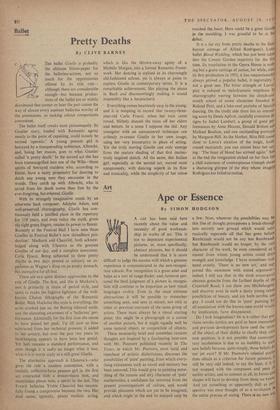Ballet
Pretty Deaths
By CLIVE BARNES THE ballet Giselle is probably the ultimate litmus-paper for the ballerina-actress, not so much for the opportunities offered by its title role— although these are considerable enough—but because produc- tions of the ballet are so widely distributed that sooner or later the part comes the way of almost every aspirant ballerina worthy of the pretensions, so making odious comparisons convenient.
The ballet itself creaks most picturesquely. Its Gautier story, loaded with Romantic agony nearly to the point of capsizing, could loosely be termed 'operatic.' A young peasant girl is betrayed by a masquerading nobleman, Albrecht, and, losing her reason, goes to what Gautier called 'a pretty death.' In the second act she has been transmogrified into one of the Wilis—those spirits of betrayed maidens who, according to Heine, have a nasty propensity for dancing to death any young men they encounter in the woods. They catch up with Albrecht, who is saved from his death worse than fate by the ever-forgiving, but ethereal, Giselle.
With its strangely imaginative music by an otherwise hack composer, Adolphe Adam, and well-preserved choreography, Giselle has con- tinuously held a justified place in the repertory for 118 years, and even today the myth, given the right green fingers, retains its power to flower. Recently at the Festival Hall I have seen three Giselles in Festival Ballet's now threadbare pro- duction : Markova and Chauvire, both acknow- ledged along with Ulanova as the greatest Giselles of our day, and a complete newcomer, Carla F,racci. Being subjected to three pretty deaths in two days proved as salutary an ex- perience as Wagner's Ring on an empty stomach, but instructive for all that.
There are two quite distinct approaches to the role of Giselle. The first, and this is Markova's, sees it primarily in terms of period style, and seeks to evoke the fugitive lightness of the well- known Chalon lithographs of the Romantic Ballet. With Markova this style is everything; the arms crooked just so, the fleeting ethereal smile, and the alienating awareness of a 'ballerina' per- formance. Admittedly for the first time she seems to have passed her peak. Up till now as time subtracted from her technical prowess, it added to her artistry, but over the past two years its bookkeeping appears to have been less genial. Yet hers remains a standard performance, and even though it is sadly no longer what it was, what it is is worth study as a still great Giselle.
The alternative approach is Ulanova's—who gives the role a modern conception, with a realistic, collective-farm peasant girl in the first act contrasted with a dream-vision (not, and materialists please note, a spirit) in the last. The French ballerina Yvette Chauvird has success- fully found a compromise between the two. Her mad scene, typically, places realistic acting, which is like the thrown-away agony of a Michele Morgan, into a formal Romantic frame- work. Her dancing is stylised in its charmingly old-fashioned echoes, yet is always at pains to exptess Giselle in contemporary terms. It is a remarkable achievement, like playing the piano in Bach and disconcertingly making it sound impossibly like a harpsichord.
' Everything comes heartlessly easy io the young. and it is tempting to record that twenty-three- year-old Carla Fracci, when her turn came round, blithely danced the tutus off her elders and betters. In a sense I suppose she did. Any youngster with an unmannered technique can artlessly re-create Giselle in her own image, using her very immaturity in place of acting. Yet the truly moving Giselle can only emerge from the mature shading of that first instinc- tively inspired sketch. All the same, this Italian girl, especially in the second act, moved most sumptuously, with dancing superb in its flow and musicality, while the simplicity of her mime touched the heart. Here could be a great Giselle in the moulding. I was grateful to be at het debut.
It is a far cry from pretty deaths to the Ilan' boyant carnage of Alfred Rodrigues's Lorca ballet Blood Wedding, which has just been take into the Covent Garden repertory for the first time. Its translation to the Opera House is notb' ing but a grave carriage of justice, for while, sines its first production in 1953, it has unquestionably always proved a popular ballet, it regrettably is not a good one. The bitter strength of Lorca's play is reduced to melodramatic emptiness bY choreography veering between the clutch-and' crutch school of erotic classicism founded bY Roland Petit, and a luke-cool pastiche of Spanisb dancing. On the credit side there lies an interest' ing score by Denis Aplvor, carefully evocative de' signs by Isabel Lambert, a group of good per' formances by Anne Heaton, Donald Britton and Michael Boulton, and one outstanding portrayal by Margaret Hill. As the Mother, Miss Hill comes close to Lorca's creation of the tragic, knife' crazed matriarch; you can almost hear her say' ing : 'The hour of blood has arrived again.' And at the end the resignation etched on her face like a chill statement of contemptuous triumph shows a shattering glimpse of the play whose imaged Rodrigues has failed to realise.














































 Previous page
Previous page